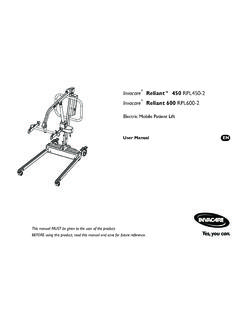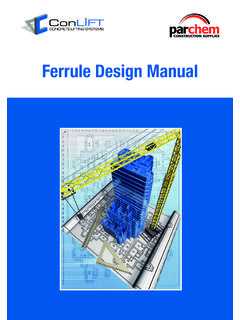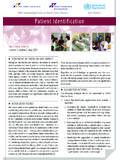Transcription of (Packaging and Packing Requirements Manual) PACKAGING ...
1 Page 1 of 12 ( PACKAGING and Packing Requirements Manual) PACKAGING , Packing , MARKING AND BAR CODING (08-11) 1. PURPOSE AND SCOPE These terms specify Requirements for PACKAGING , Packing , marking and bar coding of Products for delivery from Seller to Buyer. All Product deliveries must comply with the provisions set forth herein unless specific PACKAGING , Packing or marking Requirements are contained within applicable specifications, drawings, etc. Seller must assure package integrity throughout the shipping cycle. 2. GENERAL Requirements Products received without PACKAGING , Packing , marking and/or bar coding as set forth herein may be rejected by Buyer and returned to Seller at Seller's expense. A. PACKAGING , Packing , marking and labeling will conform to instructions specified or provided by Buyer. B. When specified in the Order, Seller shall submit PACKAGING data to Buyer for approval prior to shipment. C. Each package and pack shall provide physical, chemical and cleanliness protection to prevent damage to or deterioration of the Products.
2 All materials, fabrication techniques and workmanship shall conform to the Requirements specified below or, if not specified, otherwise meet or exceed good commercial quality and practice. D. Seller must comply with all applicable carrier regulations, including National Motor Freight Classification and Department of Transportation Regulations. E. Products susceptible to Electrostatic Discharge (ESD) must be properly packaged using electrostatic dissipating and shielding PACKAGING materials. F. Aluminum foil in PACKAGING material shall not contact metals other than cadmium, magnesium, aluminum or zinc in applications which may be exposed to water, including water vapor and condensate. 3. UNIT PACKAGING A. Determine the quantity of Product items to be included in a unit package as follows: (1) For hardware (nuts, bolts, screws, etc.), package in accordance with Addendum I. (2) As specified in the contract, Order, or specification. (3) Based on consideration of the Products characteristics, configuration, size, weight, value, criticality, PACKAGING economics, and Seller standards, unless otherwise specified by Buyer.
3 B. Any painted part, machined part or single Product item weighing over one (1) Pound shall be packaged individually to prevent metal to metal contact. C. Adequate separation, wrapping or cushioning shall be provided between parts to preclude incurring of nicks, dents, scratches or abrasions upon Products. D. Products with sharp points or protrusions shall be adequately padded to prevent damage to containers or other Products. Page 2 of 12 E. Accessory hardware shall be assembled to the Products when practical, or separately secured within the unit package. F. Unit package closure shall prevent accidental opening during shipment and storage. 4. CLEANING A. Any cleaning process may be used as long as no damage or harm occurs to the Products. B. All Products must be free of: (1) Any foreign substance which may cause the Products to deteriorate. (2) Any material which may reduce the effectiveness of any preservative compound used. 5. PRESERVATION A.
4 Products susceptible to corrosion or deterioration shall be protected through use of: preservative coatings; volatile corrosion inhibitors; desiccate packs; etc. B. The preservative used must: (1) Not damage the mechanism, structure or function of the Products by either application, removal, or use. (2) Not cause an adverse reaction with the Products. (3) Provide protection for the Products throughout shipment and for a minimum of 90 days of indoor storage following receipt. 6. WRAPPING A sheet of flexible material shall be applied around the Product item or package to prevent contamination, protect critical surfaces and barrier material from rupture, and preserve the Products. A. Wrapping material may be opaque or transparent and may possess other characteristics such as volatile corrosion inhibitor, grease-proof, heat sealable, etc. B. All wrapping shall be non-toxic and shall not cause deterioration, contamination or damage to the Products.
5 The wrapping must be of sufficient size to completely enclose the Product(s) and must be secured in place . C. When required, wrapping material shall be of a type which will provide protection against field forces, such as electrostatic and electromagnetic fields. D. Use of static generating wrapping materials is prohibited when PACKAGING ESD sensitive Products. 7. CUSHIONING, BLOCKING AND BRACING Cushioning, blocking, and/or bracing shall be used as required to protect the Products from physical and mechanical damage during shipping and handling. A. Cushioning shall meet the following Requirements : (1) Protect the Products from shock, vibration and abrasion. (2) Control the free movement of the Products within the container. (3) Convert irregular shaped Products to a configuration which may be supported within a container. Page 3 of 12 (4) Protect barriers and containers from ruptures by sharp edges or projections. B. Loose-fill cushioning materials ( , Styrofoam peanuts, shredded paper, popcorn, etc.)
6 Are prohibited. C. Newspaper and rags are unacceptable cushioning or dunnage materials. D. Use of static generating cushioning materials is prohibited when PACKAGING ESD sensitive Products. 8. CONTAINERS A. Each container shall be of minimum weight and cube consistent with standard economical designs, sizes and materials. B. Each unit, intermediate and shipping container shall be constructed to permit safe removal of the Products. C. Seller shall select unit, intermediate and shipping containers based primarily upon Product configuration and protection required during handling, shipping and storage. D. Special containers shall be used for Products which require additional features to ensure adequate protection ( , critical Products in which abrasion, shock, vibration or distortion on any surface may render the Products unfit for use). E. Reusable containers shall be used for Products which are subject to repair or overhaul. Reusable containers shall retain usefulness with minimum maintenance through the projected life span of the Products such containers support.
7 Containers must provide for easy removal of the Products without damaging or degrading the reusable value of the container. F. Bags and envelopes may be used as interior containers to protect Products from dust, water or water-vapor, as required. Closure of bags and envelopes ( , staples, tape, heat seal, etc.) shall be sufficient to ensure adequate Product restraint. G. Folding and set-up boxes are only permitted as interior unit or intermediate containers. They shall not be used as shipping containers since they will not withstand the rigors encountered during shipment. Closure, by means of tape, adhesive, stapling, etc., must be sufficient to ensure adequate Product restraint. H. Fiberboard boxes (solid or corrugated) may be used for a wide variety of products. The size, weight and type of the Products shall determine the proper style and type of fiberboard box used. Structural strength of the fiberboard box may be increased by varying the interior Packing and a degree of water resistance may be attained through use of weather resistant fiberboard and tapes.
8 Closure, by means of taping; stitching; adhesive; strapping; or any combination of these methods, must ensure adequate Product restraint. I. Wooden boxes and crates shall be used when warranted by shipping or structural Requirements based upon Product configuration, weight, or size. Closure, based upon the type of wooden box or crate used, must ensure adequate Product restraint. J. All other containers ( , metal, plastic, fiberglass, etc.), which are normally selected because of their long life and high use applications, may be used when warranted. Closure must ensure Product restraint. 9. INTERMEDIATE Packing Page 4 of 12 A. Unit packages may be placed within intermediate PACKAGING when additional Product protection is required or to permit consolidation of Products for ease in handling. B. Intermediate containers shall: (1) Include a maximum of 100 unit packs within any single intermediate container. (2) Prevent scratches, surface abrasions or other damage to Products by ensuring that each Product item (excluding hardware) is wrapped, bagged, or interleaved when more than one Product item is placed in an intermediate container.
9 (3) Be used when multiple unit packages of two (2) pounds or 200 cubic inches or less will be included in a single shipment. 10. Packing (EXTERIOR SHIPPING CONTAINERS) A. Packing shall provide adequate protection of Products during handling, shipment and storage under anticipated environmental conditions. B. Packing must comply with minimum carrier Requirements for design and fabrication. C. Products shall be cushioned, blocked and/or braced within the container to prevent damage during handling and shipment. D. Fork lift entries (skidding, pallets, etc.) shall be provided in the base of containers: (1) Weighing over 50 pounds and with dimensions exceeding a length of 48 inches and a width of 24 inches. (2) Weighing in excess of 65 pounds. E. Container fabrication shall not present any hazard to persons handling, loading or unloading them. Containers shall be securely sealed, strapped, banded, etc., to withstand anticipated transportation and storage conditions.
10 F. Containers or Product items shall not extend beyond any edge of the pallet or skid. G. Steel strapping shall not directly contact material. Corner blocking, edge protection, etc. must be placed between the material and the strapping for surface protection. 11. KITS Product items within a kit must be: A. Packaged for physical and mechanical protection. B. Identified either by part number, Product configuration, nomenclature, or individually packaged and marked. C. Physically separated from each other within the kit if the Product items react to each other. 12. HAZARDOUS MATERIALS A. Hazardous materials shall be packaged, labeled, marked, and certified in compliance with all applicable government and international laws and regulations. B. A current Materials Safety Data Sheet (MSDS) shall be submitted separately to Buyer (ATTN: Safety Manager) as set forth within the terms of the Order. C. An MSDS shall also be included with the initial shipment of material and any time the material composition changes.












